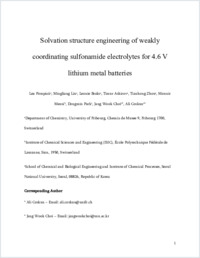Solvation Structure Engineering of Weakly Coordinating Sulfonamide Electrolytes for 4.6 V Lithium Metal Batteries
DOKPE
- Pompizii, Lea University of Fribourg
- Liu, Mingliang ORCID University of Fribourg
- Braks, Leonie University of Fribourg
- Ashirov, Timur University of Fribourg
- Zhou, Tianhong ORCID University of Fribourg
- Mensi, Mounir ISIC-EPFL, Sion, Switzerland
- Park, Dongmin Seoul National University, Republic of Korea
- Choi, Jang Wook ORCID Seoul National University, Republic of Korea
- Coskun, Ali ORCID University of Fribourg
- 2024
Submitted to:
- ACS Energy Letters. - Washington (USA): American Chemical Society (ACS). - 2024, vol. 10, no. 1, p. 1-26
energy storage
li metal batteries
electrolyte engineering
electrochemical cells
electrolytes
metals
solvation
solvents
English
A series of trifluoromethanesulfonamide solvents were synthesized with systematically controlled ring size (4−6) at the N-terminal to tune their steric and electronic properties to realize enhanced contact ion pairs for the formation of an anion-derived solid-electrolyte interface (SEI) and compatibility with the NMC811 cathode. Comparative analyses of electrolytes revealed that the 1.6 M LiFSI 1-azetidine trifluoromethanesulfonamide (AzTFSA) electrolyte presents the ideal combination of steric and electronic effects along with high oxidation stability up to 5 V and a Coulombic efficiency of 99.2% in Cu−Li half- cells at 1 mA cm−2 and 1 mAh cm−2. The corresponding full cells using 20 μm of Li foil paired with the NCM811 cathode by a negative and positive capacity ratio (N/P) of 2.5, achieve 80% capacity retention after 150 cycles at 0.5C. Even at a high charge cutoff voltage of 4.6 V, the Li|NCM811 full cell still realizes 92% retention at 0.5C after 100 cycles.
- Faculty
- Faculté des sciences et de médecine
- Department
- Département de Chimie
- Language
-
- English
- Classification
- Chemistry
- License
-
Rights reserved
- Open access status
- green
- Identifiers
-
- DOI 10.1021/acsenergylett.4c03030
- ISSN 2380-8195
- Persistent URL
- https://folia.unifr.ch/unifr/documents/330979
Statistics
Document views: 66
File downloads:
- Manuscript_Solvation_Structure_Engineering: 236
